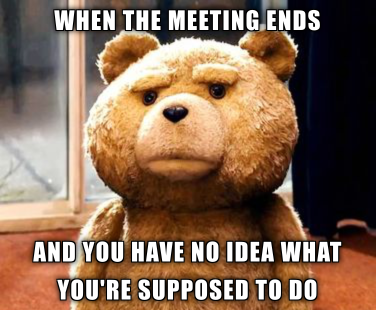From discussion to action: Why meetings aren’t the problem – and how to make decisions stick
“This meeting could have been an email!”
It’s a common complaint in modern workplaces. And yes – sometimes, it’s justified. But in many cases, the meeting itself isn’t the real issue. The deeper problem is what happens (or more often, what doesn’t happen) after everyone leaves the room or call: decisions fizzle out, ownership stays vague and follow-through is missing.
It might be time to stop blaming (only) meetings for slowing down organisations. Let’s instead explore why so many good intentions stall after the meeting ends and how you and your team can turn decisions into lasting action.
The meeting myth: Tackling the wrong problem
The narrative that “too many meetings” kill productivity is everywhere – and meeting overload is certainly real. You should always question whether the basics for a successful meeting are in place: a clear agenda, effective moderation, pre-reads when needed, the right people in the room or call, everyone prepared and a topic where discussion genuinely adds value over a simple information update.
When those conditions are met, though, frustration often comes from another factor entirely: we often mistake the meeting for the problem, when in fact the real issue lies in what happens afterwards. There’s an important distinction between discussing, deciding and implementing. The first two belong in the meeting, making sure all perspectives are heard and agreeing on what to do next. The third happens after the meeting, but it’s the make-or-break factor for whether the it ultimately delivers results.
Why decisions fizzle out
Often, it’s not the conversation during the meeting that derails progress – it’s the gap between agreement in the room and action afterward. This is where many teams stumble: commitments fade, ownership is unclear and momentum is lost. The same patterns tend to appear again and again, making it harder for decisions to translate into tangible results. Let’s look at the most common culprits behind this breakdown and how they quietly undermine even the most productive discussions:
Unclear responsibility
A decision might be made in principle, but without a named owner, it floats in no-man’s land. Everyone assumes someone else will pick it up, and in the end, no one does. This is especially common in cross-functional settings where “shared responsibility” sounds nice but means “shared neglect.”
Lack of true commitment
Nodding along in a meeting isn’t the same as genuinely agreeing to act. Sometimes people leave without being fully on board – maybe they felt unheard, maybe the decision still feels fuzzy or maybe they’re worried about the extra workload. Without explicit commitment, action slows or stalls.
No follow-through
Even with clarity and buy-in, things fall apart if there’s no structure to track progress. When outcomes aren’t documented, deadlines aren’t recorded and no one checks in on them, priorities are quickly overtaken by the next urgent thing. The result? Decisions quietly disappear from the collective memory.
These breakdowns turn a well-prepared, well-run meeting into a wasted opportunity. Avoiding them requires treating the meeting not as the finish line, but as the starting block for what comes next.

What successful teams do differently
High-performing teams know that the real success of a meeting isn’t in how well it was moderated or how lively the discussion felt. It’s whether the decisions made take root afterwards. They put as much effort into the “after” as the “during”. They have structures and processes in place to ensure that decisions are translated into concrete action steps once the meeting ends:
- Structured decision formats like RACI, decision logs or clear action trackers make general responsibilities explicit.
- Firm meeting wrap-ups answer the golden three: What exactly are we doing? Who owns it? By when will it be done?
- Transparent documentation and follow-up systems in tools like Notion, Asana or shared meeting notes make decisions visible and progress measurable.
When these habits are in place, meetings become launchpads for action and not just containers for endless conversation.
Meeting architecture as a strategic leadership tool
When leaders think beyond “just another meeting” and design a clear decision-making architecture, they set the stage for consistent follow-through. The best teams don’t leave decision execution to chance; they engineer it into their rhythm.
They establish regular decision cycles (e.g. weekly sprints or monthly strategy reviews) so progress is reviewed and course corrections happen quickly. Different meeting types are intentionally designed – whether the purpose is information-sharing, discussion or a final decision – and everyone comes in with the right mindset.
To keep outcomes sharp and actionable, they use decision templates or predefined formats. These ensure that every discussion ends with clarity on what’s next, who owns it and how progress will be checked. This deliberate structure turns meetings into a leadership instrument for alignment and momentum rather than a recurring calendar block.
Make meetings count
Meetings aren’t the enemy. But they do need to lead to real, sustained action. That requires clear decision-making, ownership and structured follow-ups.
Critically ask yourself: What decisions from the past week have not yet been implemented, and why? Was it due to unclear ownership, lack of follow-up, competing priorities or missing resources? Then, consider what you can adjust in the way you approach meetings – from setting clearer commitments to ensuring structured follow-ups – so that important decisions don’t just stay on paper but are translated into real, timely action.
👉 Would your team benefit from external support to ensure your meetings are as effective as possible? Reach out to us, we’d be happy to help you turn decisions into results.

